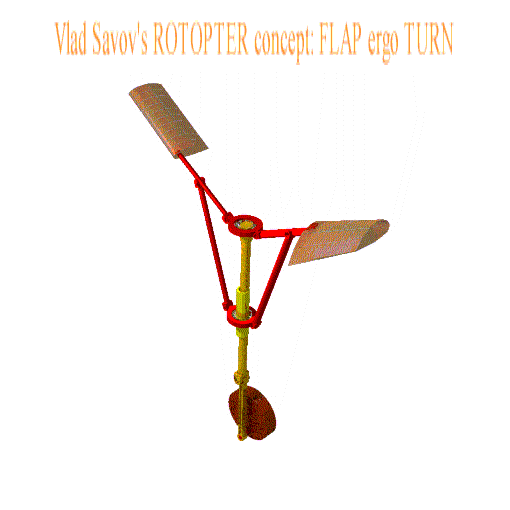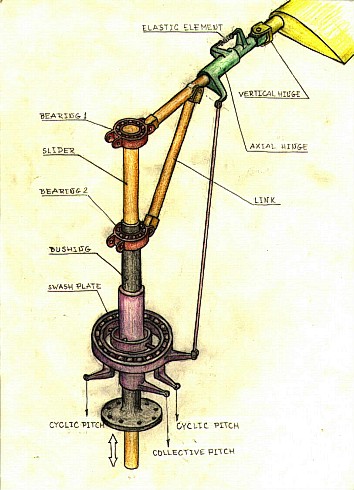
A new type of winged aircraft was proposed by
Dr. Vladimir Savov from Bulgarian Air Force Academy.
The new type of aircraft was derived from a classification of
the winged aircraft by the type of wing movements in horizontal and vertical plane.
The new rotorcraft concept was named rotopter ( from 'rotor' and 'ornithopter').
The essence of the rotopter concept is to substitute progressive motion of the flapping wing with rotation: flap ergo turn But maybe the real significance of the rotopter concept is that it allows welldeveloped helicopter rotor technology to be applied to the flapping flight. That's why the rotopter rotor to great extent looks like a helicopter rotor
The rotopter operates as follows. The crank mechanism drives the slider into reciprocal motion, which is being converted by the link mechanism into flapping of the blades. The mass characteristics of the blade and rigidity of the elastic element are selected so as to ensure changing of the blade angle of incidence lagging by 90o from the angle of flapping. The flapping blade of the rotopter creates thrust and lift similarly to the flapping wing of a bird or an insect. Due to the thrust the blade begins to rotate. Magnitude and direction of the lift force is controlled via the swash plate mechanism analogously to the way it is carried out on the helicopter rotor. When in progressive flight, velocity head on the advanced blade is greater than the head on the retreating one, respectively the lift on the advanced blade is greater than on the retreating. Increased lift creates greater nose-down moment around the axial hinge, the angle of incidence decreases, so does the lift and the banking moment is being reduced.

It is expected that the rotopter has some advantages in comparison with the helicopter rotor:
 there is no torque reaction;
there is no torque reaction;
 the induced power losses are possibly lower due to the unsteady flow.;
the induced power losses are possibly lower due to the unsteady flow.;
The rotopter has certain advantages in comparison with the ornithopter:
 velocity triangles in different crossections along the rotopter blade are geometrically similar, hence no twisting is necessary;
velocity triangles in different crossections along the rotopter blade are geometrically similar, hence no twisting is necessary;
 the forward speed of the blade is not directly connected with the speed of the aircraft, hence vertical flight or maintaining optimal speed of rotation when in level flight is possible;
the forward speed of the blade is not directly connected with the speed of the aircraft, hence vertical flight or maintaining optimal speed of rotation when in level flight is possible;
 the centrifugal force reduces compressive stress on the upper surface of the blade.
the centrifugal force reduces compressive stress on the upper surface of the blade.
The unfavorable load distribution along the blade, the cyclic variation of the lift and increased due to the centrifugal forces bending moment at the root of the blade probably confine the use of the rotopter concept for small aircraft only (micro air vehicles).
At the current moment the development of the rotopter concept is in the following state:
 mathematical model of the rotopter aerodynamics based on the element-impulse theory has been created and used for optimizing rotopter kinematics.
mathematical model of the rotopter aerodynamics based on the element-impulse theory has been created and used for optimizing rotopter kinematics.
 laboratory model was built, allowing measuring of the lift and consumed power. The experiments with the laboratory model demonstrated that the concept of the rotopter works i.e. the blades rotate and create lift force. It was also ascertained that the efficiency of the rotopter is ultimately sensitive to the law of variation of the blade angle of incidence. At the current stage, achieved coefficient of efficiency of the rotopter is considerably less than the usual for a conventional helicopter rotor. There is hope that if more sophisticated numerical model of the flow around rotopter blade is developed and the motion of the blade is optimized, the efficiency coefficient of the rotopter will exceed the one of a conventional rotor.
laboratory model was built, allowing measuring of the lift and consumed power. The experiments with the laboratory model demonstrated that the concept of the rotopter works i.e. the blades rotate and create lift force. It was also ascertained that the efficiency of the rotopter is ultimately sensitive to the law of variation of the blade angle of incidence. At the current stage, achieved coefficient of efficiency of the rotopter is considerably less than the usual for a conventional helicopter rotor. There is hope that if more sophisticated numerical model of the flow around rotopter blade is developed and the motion of the blade is optimized, the efficiency coefficient of the rotopter will exceed the one of a conventional rotor.
 a small (20 cm) flying model is under construction.
a small (20 cm) flying model is under construction.
It is early to predict what the rotopter could be used for besides completing the list of the winged aircraft. Let's hope that the fresh main idea and existing rotor technology will ensure fast developing of the new hatched out rotopteryx.
| Wing movement | In horizontal plane | ||
| translational | rotational | ||
| In vertical plane | no movement | airplane | helicopter |
| reciprocal | ornithopter | ? | |
The new rotorcraft concept was named rotopter ( from 'rotor' and 'ornithopter').
The essence of the rotopter concept is to substitute progressive motion of the flapping wing with rotation: flap ergo turn But maybe the real significance of the rotopter concept is that it allows welldeveloped helicopter rotor technology to be applied to the flapping flight. That's why the rotopter rotor to great extent looks like a helicopter rotor
The rotopter operates as follows. The crank mechanism drives the slider into reciprocal motion, which is being converted by the link mechanism into flapping of the blades. The mass characteristics of the blade and rigidity of the elastic element are selected so as to ensure changing of the blade angle of incidence lagging by 90o from the angle of flapping. The flapping blade of the rotopter creates thrust and lift similarly to the flapping wing of a bird or an insect. Due to the thrust the blade begins to rotate. Magnitude and direction of the lift force is controlled via the swash plate mechanism analogously to the way it is carried out on the helicopter rotor. When in progressive flight, velocity head on the advanced blade is greater than the head on the retreating one, respectively the lift on the advanced blade is greater than on the retreating. Increased lift creates greater nose-down moment around the axial hinge, the angle of incidence decreases, so does the lift and the banking moment is being reduced.

It is expected that the rotopter has some advantages in comparison with the helicopter rotor:
The rotopter has certain advantages in comparison with the ornithopter:
The unfavorable load distribution along the blade, the cyclic variation of the lift and increased due to the centrifugal forces bending moment at the root of the blade probably confine the use of the rotopter concept for small aircraft only (micro air vehicles).
At the current moment the development of the rotopter concept is in the following state:
It is early to predict what the rotopter could be used for besides completing the list of the winged aircraft. Let's hope that the fresh main idea and existing rotor technology will ensure fast developing of the new hatched out rotopteryx.
